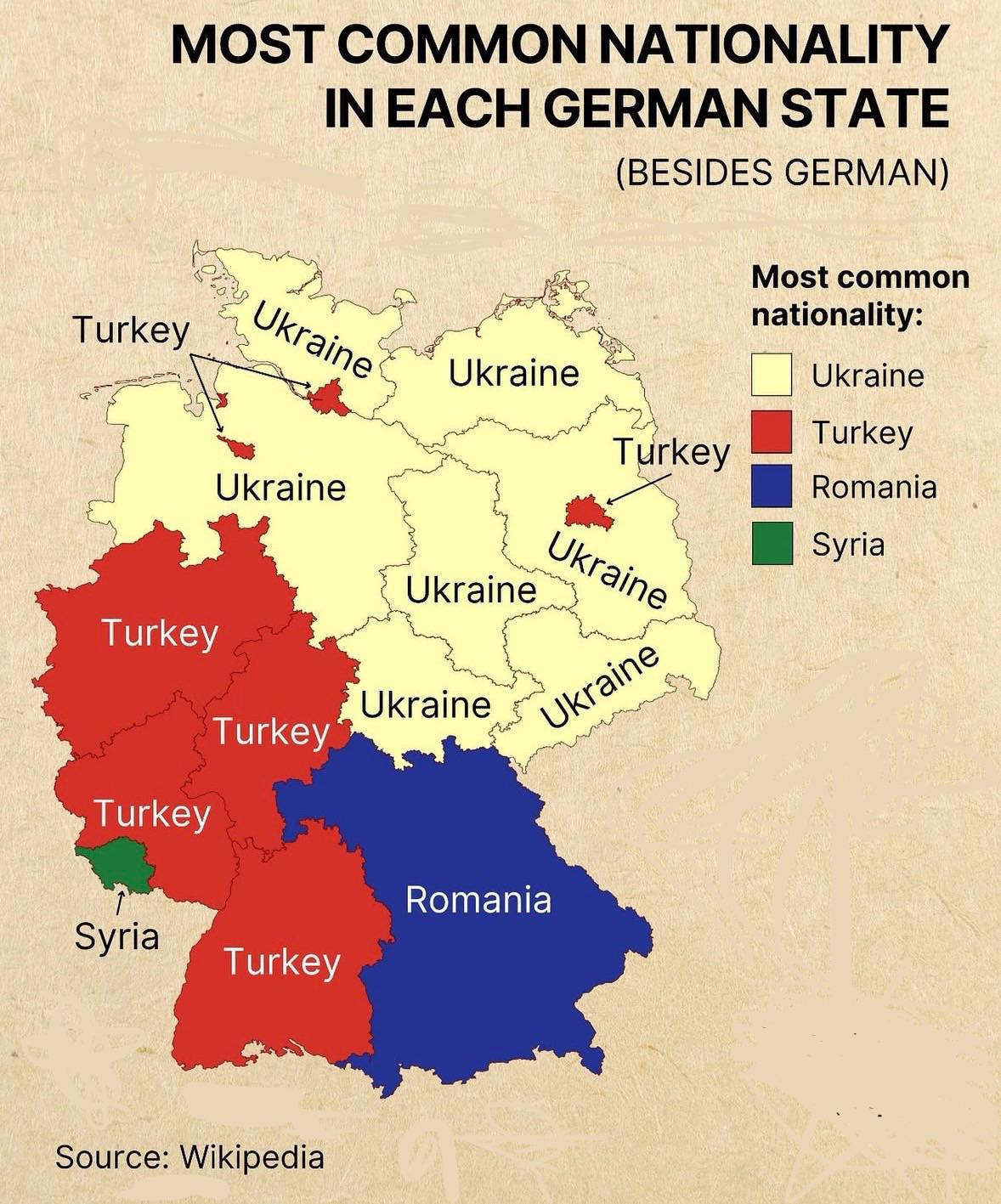Most Common Nationality in Each German State Map


David Chen
Data Visualization Specialist
David Chen is an expert in transforming complex geographic datasets into compelling visual narratives. He combines his background in computer science ...
Geographic Analysis
What This Map Shows
The "Most Common Nationality in Each German State" map provides a clear visual representation of the predominant foreign nationalities residing in Germany's 16 federal states. Germany, with its rich history of immigration, has transformed into a multicultural hub, and this map distinctly highlights the varied national backgrounds of its inhabitants. Each state is marked with the nationality that has the highest population, showcasing the diverse tapestry of cultures that contribute to Germany's identity.
Deep Dive into Immigration Patterns in Germany
Germany has long been a destination for immigrants, due in part to its strong economy, educational opportunities, and social welfare system. In recent years, the country has seen an influx of individuals from various regions, each contributing to the local culture and economy. According to the Federal Statistical Office, as of 2022, about 21.9% of the population in Germany were immigrants or had immigrant backgrounds.
Interestingly, there are significant variations in the most common nationalities across different states. For instance, in states like North Rhine-Westphalia, Turkish nationals represent the largest foreign group. This can be traced back to the labor recruitment agreements between Germany and Turkey in the 1960s, which encouraged many Turks to migrate for work. In contrast, in states such as Bavaria, the predominant nationality is Polish. This reflects the more recent migration patterns where many Poles have moved to Germany in search of better job opportunities.
Moreover, states like Berlin showcase a different trend; here, the largest foreign community consists of individuals from Syria, a reflection of the recent refugee crises. The city's vibrant mix of cultures is visible in its neighborhoods, culinary offerings, and social fabric. Notably, the state of Hesse is home to a large population of Italians, a connection that stems from post-war labor migration.
In addition, the state of Baden-Württemberg has a significant population of Romanians, highlighting the increasing trend of migration from Eastern Europe. The changing demographics indicate not just the historical immigration patterns but also the evolving economic relations within Europe.
These patterns are not static. As the European Union continues to evolve and policies change, the dynamics of immigration will also shift. The map thus not only serves as a snapshot of the current situation but also provides insight into the ongoing trends in migration and settlement in Germany.
Regional Analysis
Examining the map closely, we can observe notable differences between eastern and western Germany. For example, in the east, states like Saxony and Thuringia have lower percentages of foreign nationals compared to their western counterparts. This is primarily due to the historical context of these regions, where immigration did not play as significant a role during the post-war period compared to Western Germany.
Interestingly, states like Schleswig-Holstein and Hamburg reflect a diverse array of nationalities, including a high number of Vietnamese immigrants, a legacy of historical ties between the two nations. This contrasts sharply with the more homogenous demographic structure seen in some eastern states.
The urban-rural divide is also evident. Major cities such as Frankfurt and Stuttgart are melting pots of nationalities, attracting individuals from across the globe due to their economic opportunities. In contrast, rural areas tend to show a more uniform demographic, with fewer foreign nationals. This urban concentration of diverse nationalities often leads to vibrant multicultural communities, fostering social cohesion as well as challenges like integration and social services.
Significance and Impact
Understanding the distribution of nationalities across German states holds significant importance for several reasons. First, it provides insight into the cultural and social dynamics within each region. Cities with a high concentration of foreign nationals often showcase rich cultural festivals, diverse culinary scenes, and a unique blend of traditions that contribute to the overall German culture.
Moreover, these demographics play a crucial role in shaping economic policies and community initiatives. For instance, local governments may focus on language integration programs or cultural exchange initiatives to foster inclusivity and cohesion among diverse populations.
As the landscape of immigration continues to shift, with current discussions surrounding EU policies and global mobility trends, it is likely that the map will evolve over time. Analysts predict that the demographics of Germany will continue to diversify, thereby enriching the national identity while also presenting challenges that require thoughtful policy responses. Understanding these trends is crucial, not only for policymakers but also for citizens who seek to navigate and appreciate the multicultural environment that defines modern Germany.
Ultimately, the "Most Common Nationality in Each German State" map is more than just a representation of numbers; it's a reflection of the human stories and histories that shape the fabric of German society today.
Visualization Details
- Published
- August 17, 2025
- Views
- 124
Comments
Loading comments...